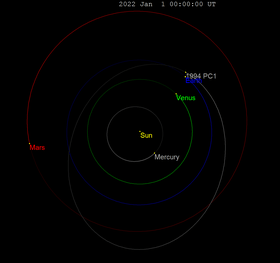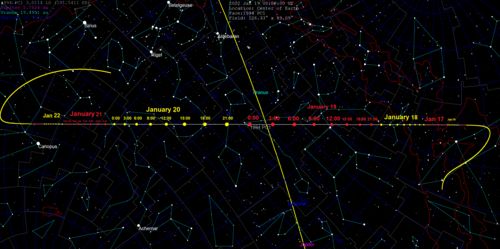(7482) 1994 PC1
(7482) 1994 PC1 is a stony asteroid, classified as near-Earth object and potentially hazardous asteroid of the Apollo group, approximately 1.1 kilometers in diameter. It was discovered on 9 August 1994, by astronomer Robert McNaught at the Siding Spring Observatory in Coonabarabran, Australia.[2]
 Orbit and positions on 1 January 2019 | |
| Discovery [1] | |
|---|---|
| Discovered by | R. H. McNaught |
| Discovery site | Siding Spring Obs. |
| Discovery date | 9 August 1994 |
| Designations | |
| (7482) 1994 PC1 | |
| 1994 PC1 | |
| Apollo · NEO · PHA [1][2] | |
| Orbital characteristics [1] | |
| Epoch 4 September 2017 (JD 2458000.5) | |
| Uncertainty parameter 0 | |
| Observation arc | 41.97 yr (15,331 days) |
| Aphelion | 1.7882 AU |
| Perihelion | 0.9042 AU |
| 1.3462 AU | |
| Eccentricity | 0.3283 |
| 1.56 yr (571 days) | |
| 47.475° | |
| 0° 37m 51.6s / day | |
| Inclination | 33.487° |
| 117.89° | |
| 47.625° | |
| Earth MOID | 0.0010 AU (0.4 LD) |
| Physical characteristics | |
| Dimensions | 1.052±0.303 km[3] 1.30 km (calculated)[4] |
| 2.5999 h[5] | |
| 0.20 (assumed)[4] 0.277±0.185[3][3] | |
| SMASS = S [1][4] | |
| 16.8[1][4] · 16.80±0.3[3] | |
Orbit and classification
1994 PC1 orbits the Sun at a distance of 0.9–1.8 AU once every 1 years and 7 months (571 days). Its orbit has an eccentricity of 0.33 and an inclination of 33° with respect to the ecliptic.[1]
On 17 January 1933, it passed 0.00752 AU (1,125,000 km; 699,000 mi) from Earth. On 18 January 2022, it will pass 0.01324 AU (1,981,000 km; 1,231,000 mi) from Earth.[1]
Physical characteristics
In the SMASS classification, 1994 PC1 is a common stony S-type asteroid.[1][4]
Rotation period
In 1998, a rotational lightcurve of 1994 PC1 was obtained from photometric observations by Petr Pravec. Lightcurve analysis gave a well-defined rotation period of 2.5999 hours with a brightness amplitude of 0.29 magnitude (U=3).[5]
Diameter and albedo
According to the survey carried out by the NEOWISE mission of NASA's Wide-field Infrared Survey Explorer, 1994 PC1 measures 1.052 kilometers in diameter and its surface has an albedo of 0.277.[3] The Collaborative Asteroid Lightcurve Link assumes an albedo of 0.20 and calculates a diameter of 1.30 kilometers based on an absolute magnitude of 16.8.[4]
2022 flyby
On 19 January 2022, 1994 PC1 will pass just outside of 3 lunar distances of the earth, with a peak magnitude of 7-8.
 |
| PHA | Date | Approach distance (lunar dist.) | Abs. mag (H) |
Diameter (C) (m) |
Ref (D) | ||
|---|---|---|---|---|---|---|---|
| Nomi- nal(B) |
Mini- mum |
Maxi- mum | |||||
| (33342) 1998 WT24 | 1908-12-16 | 3.542 | 3.537 | 3.547 | 17.9 | 556–1795 | data |
| (458732) 2011 MD5 | 1918-09-17 | 0.911 | 0.909 | 0.913 | 17.9 | 556–1795 | data |
| (7482) 1994 PC1 | 1933-01-17 | 2.927 | 2.927 | 2.928 | 16.8 | 749–1357 | data |
| 69230 Hermes | 1937-10-30 | 1.926 | 1.926 | 1.927 | 17.5 | 668–2158 | data |
| 69230 Hermes | 1942-04-26 | 1.651 | 1.651 | 1.651 | 17.5 | 668–2158 | data |
| (137108) 1999 AN10 | 1946-08-07 | 2.432 | 2.429 | 2.435 | 17.9 | 556–1795 | data |
| (33342) 1998 WT24 | 1956-12-16 | 3.523 | 3.523 | 3.523 | 17.9 | 556–1795 | data |
| (163243) 2002 FB3 | 1961-04-12 | 4.903 | 4.900 | 4.906 | 16.4 | 1669–1695 | data |
| (192642) 1999 RD32 | 1969-08-27 | 3.627 | 3.625 | 3.630 | 16.3 | 1161–3750 | data |
| (143651) 2003 QO104 | 1981-05-18 | 2.761 | 2.760 | 2.761 | 16.0 | 1333–4306 | data |
| 2017 CH1 | 1992-06-05 | 4.691 | 3.391 | 6.037 | 17.9 | 556–1795 | data |
| (170086) 2002 XR14 | 1995-06-24 | 4.259 | 4.259 | 4.260 | 18.0 | 531–1714 | data |
| (33342) 1998 WT24 | 2001-12-16 | 4.859 | 4.859 | 4.859 | 17.9 | 556–1795 | data |
| 4179 Toutatis | 2004-09-29 | 4.031 | 4.031 | 4.031 | 15.30 | 2440–2450 | data |
| 2014 JO25 | 2017-04-19 | 4.573 | 4.573 | 4.573 | 17.8 | 582–1879 | data |
| (137108) 1999 AN10 | 2027-08-07 | 1.014 | 1.010 | 1.019 | 17.9 | 556–1795 | data |
| (35396) 1997 XF11 | 2028-10-26 | 2.417 | 2.417 | 2.418 | 16.9 | 881–2845 | data |
| (154276) 2002 SY50 | 2071-10-30 | 3.415 | 3.412 | 3.418 | 17.6 | 714–1406 | data |
| (164121) 2003 YT1 | 2073-04-29 | 4.409 | 4.409 | 4.409 | 16.2 | 1167–2267 | data |
| (385343) 2002 LV | 2076-08-04 | 4.184 | 4.183 | 4.185 | 16.6 | 1011–3266 | data |
| (52768) 1998 OR2 | 2079-04-16 | 4.611 | 4.611 | 4.612 | 15.8 | 1462–4721 | data |
| (33342) 1998 WT24 | 2099-12-18 | 4.919 | 4.919 | 4.919 | 17.9 | 556–1795 | data |
| (85182) 1991 AQ | 2130-01-27 | 4.140 | 4.139 | 4.141 | 17.1 | 1100 | data |
| 314082 Dryope | 2186-07-16 | 3.709 | 2.996 | 4.786 | 17.5 | 668–2158 | data |
| (137126) 1999 CF9 | 2192-08-21 | 4.970 | 4.967 | 4.973 | 18.0 | 531–1714 | data |
| (290772) 2005 VC | 2198-05-05 | 1.951 | 1.791 | 2.134 | 17.6 | 638–2061 | data |
| (A) List includes near-Earth approaches of less than 5 lunar distances (LD) of objects with H brighter than 18. (B) Nominal geocentric distance from the Earth's center to the object's center (earth radius≈6400 km). (C) Diameter: estimated, theoretical mean-diameter based on H and albedo range between X and Y. (D) Reference: data source from the JPL SBDB, with AU converted into LD (1 AU≈390 LD) (E) Color codes: unobserved at close approach observed during close approach upcoming approaches | |||||||
Naming
As of 2018, this minor planet has not been named.[2]
References
- "JPL Small-Body Database Browser: 7482 (1994 PC1)" (2016-09-12 last obs.). Jet Propulsion Laboratory. Retrieved 2 November 2017.
- "7482 (1994 PC1)". Minor Planet Center. Retrieved 2 November 2017.
- Mainzer, A.; Grav, T.; Masiero, J.; Bauer, J.; Cutri, R. M.; McMillan, R. S.; et al. (November 2012). "Physical Parameters of Asteroids Estimated from the WISE 3-Band Data and NEOWISE Post-Cryogenic Survey". The Astrophysical Journal Letters. 760 (1): 6. arXiv:1210.0502. Bibcode:2012ApJ...760L..12M. doi:10.1088/2041-8205/760/1/L12.
- "LCDB Data for (7482)". Asteroid Lightcurve Database (LCDB). Retrieved 2 November 2017.
- Pravec, Petr; Wolf, Marek; Sarounová, Lenka (November 1998). "Lightcurves of 26 Near-Earth Asteroids". Icarus. 136 (1): 124–153. Bibcode:1998Icar..136..124P. doi:10.1006/icar.1998.5993.
External links
- Asteroid Lightcurve Database (LCDB), query form (info)
- Dictionary of Minor Planet Names, Google books
- Asteroids and comets rotation curves, CdR – Observatoire de Genève, Raoul Behrend
- Discovery Circumstances: Numbered Minor Planets (5001)-(10000) – Minor Planet Center
- (7482) 1994 PC1 at NeoDyS-2, Near Earth Objects—Dynamic Site
- Ephemeris · Obs prediction · Orbital info · MOID · Proper elements · Obs info · Close · Physical info · NEOCC
- (7482) 1994 PC1 at the JPL Small-Body Database
